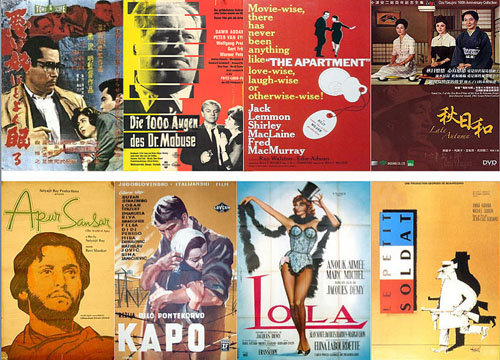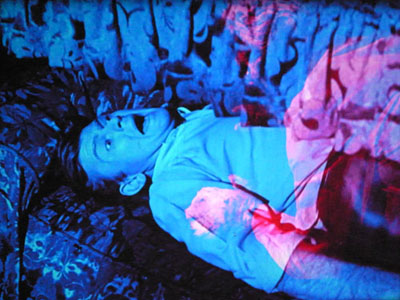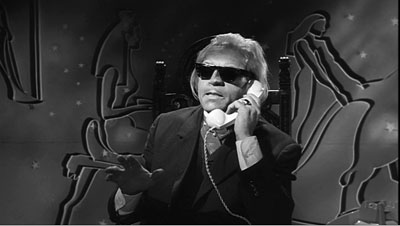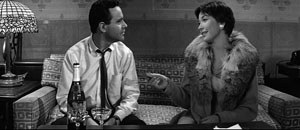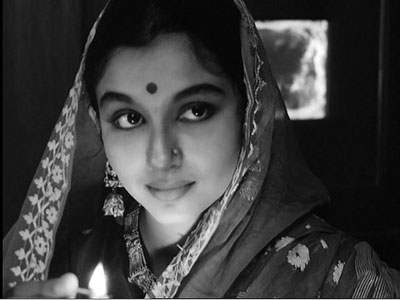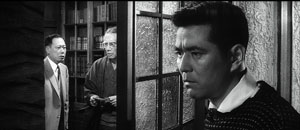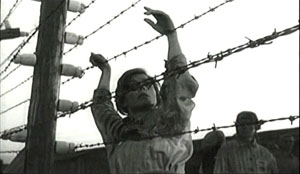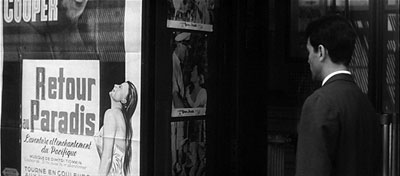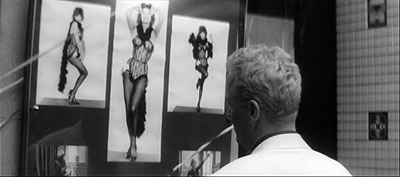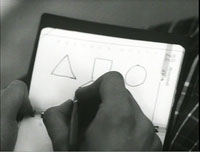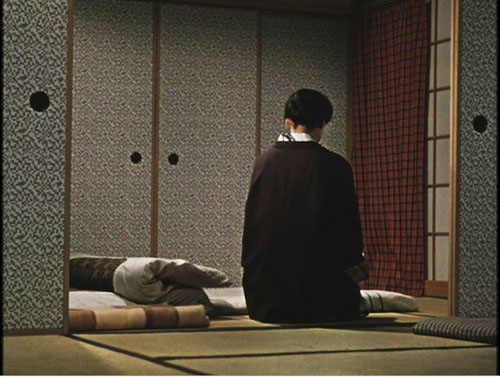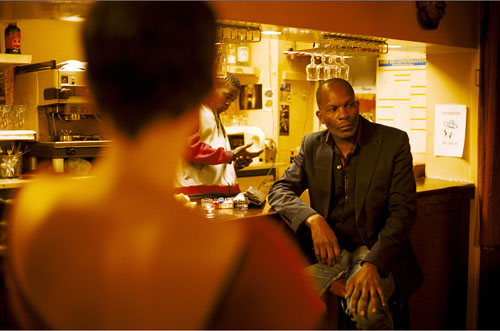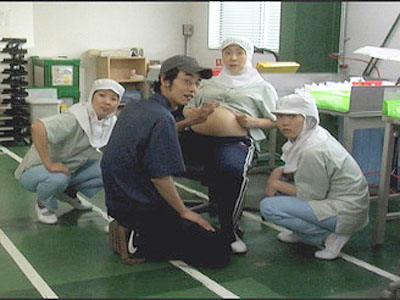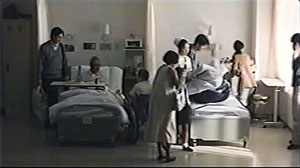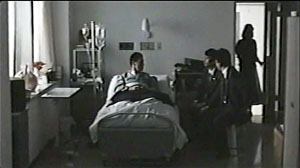Archive for the 'Film technique: Cinematography' Category
Daisies in the crevices
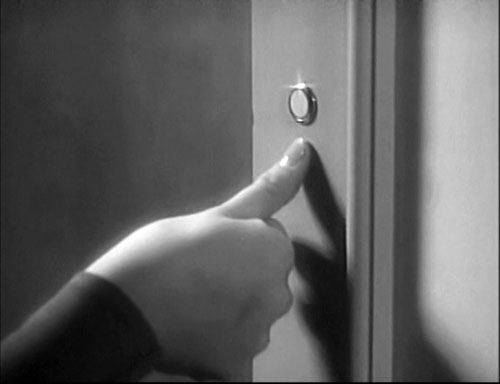
DB here:
If you wanted a prototype of some unique visual pleasures of 1930s cinema, you could do worse than pick this innocuous image. It’s perfunctory in narrative terms, merely telling us that Sylvia Day is calling on Bill Smith. Beyond its plot function, though, it’s fun to see. We can enjoy the unfussy modern edge of the doorjamb, the curve of the manicured thumb, and soft highlights bringing out the hand and knuckles.
Above all, there is that starry gleam at the top of the doorbell. Who needs it? It’s just a doorbell. Why take so much trouble lighting a throwaway shot?
Add to this that Parole Girl (1933) is a program picture, and from Columbia, no less—the Poverty Row studio that had yet to break through with It Happened One Night (1934). We learn from Bernard F. Dick’s deeply-researched book on Harry Cohn that the budget for Parole Girl would have been about $250,000, when MGM B’s were running about $400,000. Why spend money on a shot like this?
Because that was the standard of good-looking moviemaking at the time. Most problems of converting to talkies had been solved, so films were regaining not only the fluent narration but the sparkling imagery of 1920s cinema. Under Cohn’s leadership, Columbia was trying to compete with the bigger studios’ movies, and looking classy was one way to do it. Recently I spent a day or so watching four titles, and I was reminded how pictorially sophisticated and refreshing low-end Hollywood can be. These movies also offer us an unusual window into what was already characteristic storytelling strategies of classical Hollywood. But there will be spoilers ahead too.
Welcome to 1933
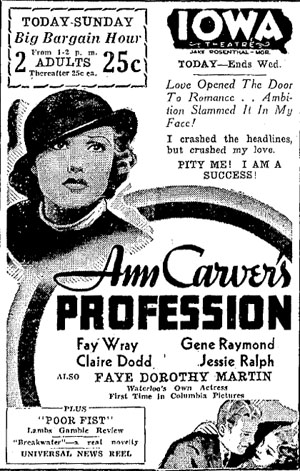
As so often, I have TCM to thank. Since their Jean Arthur tribute of 2007, they have been running a generous number of Columbia titles (all restored by the master hand of Grover Crisp). By including less-known 1930s items along with classics like The Awful Truth and the Capra titles, they continue their mission of serving American film culture every hour.
Lea Jacobs has convinced me that it’s useful to think of studio releases in those days as filling a season running from Labor Day to Memorial Day rather than a calendar year. Studio heads planned budgets and production schedules according to that time frame, like network TV broadcasters now. Unlike today, summer was not a big release period, maybe because of the competition of other leisure activities, maybe because with air-conditioned movie houses people would come watch anything thrown on the screen. In any case, the big pictures were saved for fall, winter, and spring.
So my frame of reference is the 1932-33 season. Columbia ushered in the new year with its best-remembered film of the season, Capra’s Bitter Tea of General Yen (6 January). The studio probably considered Washington Merry-Go-Round (15 October), Virtue (25 October), and No More Orchids (15 November) to be A projects, but the large output of Westerns, the absence of historical pictures, and the relative dearth of stars in this output confirm the studio’s status as a Poverty Row company.
My movies come from the winter and spring of 1933. Each was shot in two to three weeks and each runs about seventy minutes.
Air Hostess (15 January, directed by Albert Rogell) tells of the daughter of a WWI ace who marries a reckless young pilot. Trying to build a new type of plane, he shops his business plans to a rich woman investor, who tries to seduce him.
In Child of Manhattan (4 February, directed by Edward Buzzell), a wealthy widower falls for a taxi dancer and takes her as his mistress. When she becomes pregnant, he marries her. But the baby dies soon after birth and the wife flees to Mexico for a divorce while the husband tries to track her down.
In Parole Girl (4 March, directed by Edward Cline), a department store executive sends a woman con artist to prison. She vows revenge. When she gets out, she seduces the executive, although he’s unaware of who she is.
Ann Carver’s Profession (26 May 1933, directed by Buzzell) centers on a couple torn by career rivalry. After being a gridiron hero in college, the husband is failing as an architect. Meanwhile, his wife is becoming a celebrated trial lawyer. Eventually the husband leaves the household and takes up with a floozie, who winds up strangled. His wife must defend him against the murder charge.
For connoisseurs of naughty pre-Code movies, there are the usual attractions of double beds, extramarital sex, peekaboo negligees, and risqué dialogue. Child of Manhattan goes the farthest, perhaps because it’s an adaptation of a Preston Sturges play. “You’re a fascinating little witch,” says the millionaire. “Did you say witch?” the dancer asks. This is the same girl, played by perky Nancy Carroll, who thinks the man is trying to feel her up when he slips a thousand-dollar bill into her garter. Later she recalls her mother’s advice: “Never, ever walk upstairs in front of a gentleman.” And when she confesses to her Texan admirer in her mangled pronunciation, “I’m a courtesian,” he pauses and replies, “Well, religion doesn’t make any difference with me.”
Despite such pleasant moments, and two screenplays credited to Robert Riskin and Norman Krasna, these movies won’t win prizes for imaginative scripting. The tone is often uncertain, with comic banter clashing with scenes of melodramatic sacrifice. The long arm of coincidence becomes elastic. In Parole Girl, the heroine happens to meet the offending executive’s first wife in prison. During the taxi dancer’s stay in Mexico, she runs into the cowpoke who had wooed her aggressively in Manhattan. In Ann Carver’s Profession, the husband’s girlfriend accidentally strangles herself. Yes, you read that correctly.
Still, you have to give points for speed. Only Parole Girl has unusually quick cutting, at an average of 6.6 seconds per shot, but the overall pace of most of the plots is pretty rapid. (The exception is Child of Manhattan, whose lumbering dramatic rhythm is echoed in an average shot length of sixteen seconds.) Playing far-fetched action fast makes it less noticeable and more forgivable. Today any movie that can tell a moderately interesting story in a little more than an hour feels like a triumph. You can watch two of my pictures in the time it takes to groan your way through Funny People. And in these movies, the opening credits flash by in less than fifty seconds. Those were the days when crafts people under contract didn’t have to be acknowledged, and there were no executive producers.
Apart from Capra, whom do we remember as a Columbia director? Probably not my three guys. Albert Rogell, director of Air Hostess, began directing in the early 20s and worked for Columbia, Tiffany, Monogram, RKO, Universal, and Paramount. A prototypical B filmmaker, he signed over a hundred films in twenty-five years. Edward Buzzell was somewhat more prominent. After Ann Carver’s Profession, he left Columbia for Universal and eventually moved to MGM, where he directed (as if that were possible) the Marx Brothers in At the Circus (1939) and Go West (1940), as well as helming Song of the Thin Man (1947). Like Rogell, Edward Cline (Parole Girl) skipped among studios; like Buzzell, he landed on his feet with comedian comedy, steering W. C. Fields through You Can’t Cheat an Honest Man (1939), My Little Chickadee (1940), and other vehicles. In all, studio artisans, yes; auteurs, no.
Two Joes and a Ted
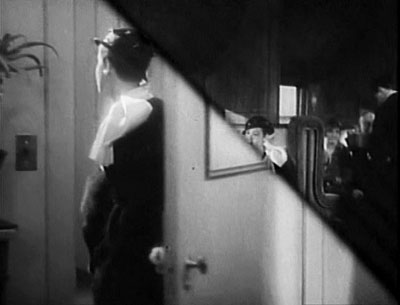
Parole Girl
If you’re interested in how Hollywood tells its tales, there’s a fair amount to chew on in these modest releases. The scripts tend to obey Kristin’s four-part model, adapted to very short running times, with the key turning point taking place midway through the film. Despite the coincidences, the characters’ goals and changes of heart tend to be planted early. In Ann Carver’s Profession, Ann’s intense ambition and Bill’s swaggering overconfidence prepare us for the crisis in their marriage, when each is unwilling to compromise.
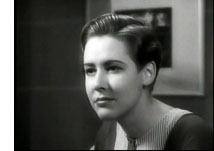 As for performances, perhaps the very speed of production forced actors to play naturally. True, Fay Wray is a bit arch as Ann Carver, but Gene Raymond as her husband moves convincingly from boisterousness to self-doubt. In Child of Manhattan, John Boles, trying to mingle with the little people, can be stiff, but Nancy Carroll has pep, and Buck Jones as her cowboy swain adds a welcome dose of naive gallantry. All three show how important distinct voices had already become: Boles mellifluous, Carroll up and down the scale, Jones slow and sincere. Reliable Columbia regular Ralph Bellamy shows up in Parole Girl, but more memorable is the performance, or rather presence, of Mae Clark. When she comes back from prison bent on vengeance, she’s a glowering figure in her stylishly chopped hairdo.
As for performances, perhaps the very speed of production forced actors to play naturally. True, Fay Wray is a bit arch as Ann Carver, but Gene Raymond as her husband moves convincingly from boisterousness to self-doubt. In Child of Manhattan, John Boles, trying to mingle with the little people, can be stiff, but Nancy Carroll has pep, and Buck Jones as her cowboy swain adds a welcome dose of naive gallantry. All three show how important distinct voices had already become: Boles mellifluous, Carroll up and down the scale, Jones slow and sincere. Reliable Columbia regular Ralph Bellamy shows up in Parole Girl, but more memorable is the performance, or rather presence, of Mae Clark. When she comes back from prison bent on vengeance, she’s a glowering figure in her stylishly chopped hairdo.
The films make fluent use of storytelling devices that predate the 1930s but are forever associated with that decade. Sequences are linked through headline montages and wipes, recently made possible by the optical printer. There are more elaborate techniques too, particular the visual or auditory hook connecting scenes. We’re not surprised to see commonplace instances, as when a note pad listing an apartment number dissolves to that number on the door. In Air Hostess, however, a spinning propeller gives way to a roulette wheel, and this association does a little more work, linking Ted Hunter’s reckless flying to his gambling and his general tendency to take risks.
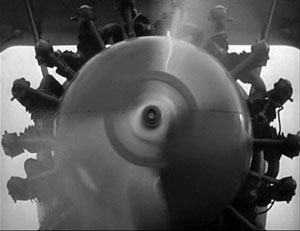
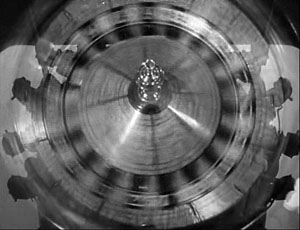
In Child of Manhattan, as Madeleine resolves to leave her husband after the death of her child, she tearfully shakes a baby rattle, and this dissolves to marimbas in a nightclub, swiftly turning her pathos into her effort to start a new life with a Mexican divorce.

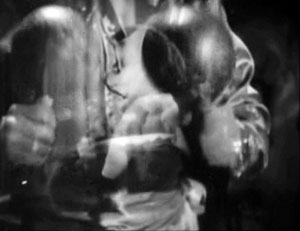
But what is perhaps most striking about these films is their photography. Ten minutes into Air Hostess, the first one I watched, we get a lovely sustained track into a sunny airfield, our view guided by the walkway wheeled up to a plane door as passengers step out.
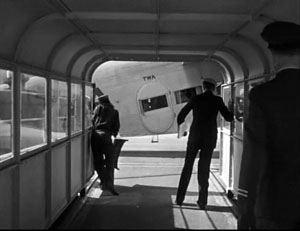
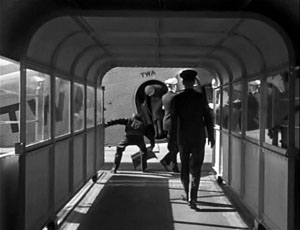
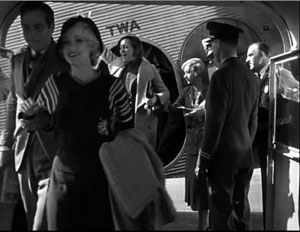
The relaxed play of light and shadow in this geometrical shot yields one of those fugitive visual delights that classic cinema so often supplies.
What’s it doing in a Columbia programmer? This Poverty Row studio realized that they could give their pinched budgets an upscale look with polished cinematography. Accordingly, you can argue that the biggest talents on the Columbia lot were the directors of photography. Our four films were shot by ace DP’s.
Joe August (Parole Girl) was the grand old man. He filmed some of the best-looking hits of the 1910s, including Ince’s Civilization (1916) and a great many William S. Hart movies (including Hell’s Hinges, 1916). In the 1920s and up to 1932 he worked at Fox on films by Ford, Hawks, and Milestone. At Columbia August would shoot Borzage projects like Man’s Castle (1933) before moving to RKO for Sylvia Scarlett (1936), Dance, Girl, Dance (1940), and the flamboyant All That Money Can Buy (aka The Devil and Daniel Webster, 1940).
Another Joe, somewhat younger, was no less gifted. Joseph Walker, the DP of Air Hostess came to Columbia early and soon teamed with Capra; he would shoot twenty movies with the director, including the splendid American Madness (1932), a particular favorite of mine. Walker stayed loyal to Columbia, shooting Only Angels Have Wings (1939), His Girl Friday (1940), Penny Serenade (1941), and on and on—returning to Capra for the independent production It’s a Wonderful Life (1947). Walker also patented an original zoom-lens design.
Ted, sometimes known as Teddy, Tetzlaff was another Columbia loyalist, and he certainly cranked them out. Hawks’ The Criminal Code was one of eleven movies Tetzlaff was credited with in calendar 1931. But by the spring of 1933 he seems already to have become a free lance, eventually working at Paramount on a string of classics (Easy Living, Remember the Night, Road to Zanzibar), then RKO (The Enchanted Cottage, Notorious), and occasional jobs back at Columbia. Tetzlaff became a director as well, remembered chiefly for the cult classic The Window (1949).
No wonder my four films dazzle, even on TV. According to Bob Thomas’s biography King Cohn, Columbia took special care to create a phosphorescent look through careful processing that enhanced the DPs’ efforts. Hence not only the sparkle on a door buzzer but glowing applications of then-standard edge lighting. Hence as well the use of striped shadows to suggest venetian blinds, a convention we associate with the forties but here in precise array (Child of Manhattan, Parole Girl).
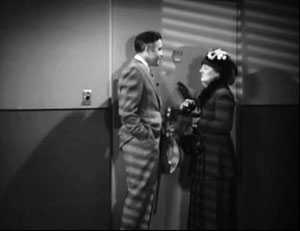
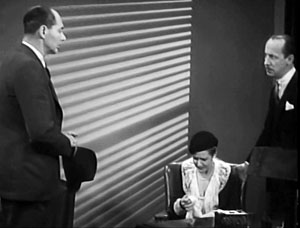
Trust Joe Walker to provide a little of that striped texture with a fuselage.
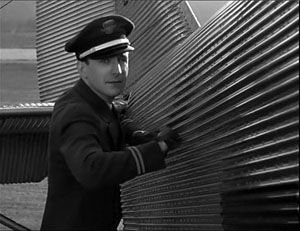
Hence too some striking depth. Here is the next-to-last shot of Walker’s work in Air Hostess, the sort of fancy aperture composition that crops up surprisingly often in the 1930s.
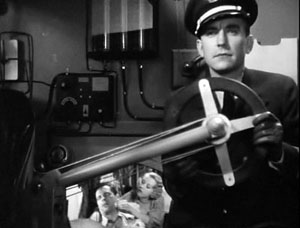
Tetzlaff, first in Child of Manhattan and then Ann Carver’s Profession, seems to be fooling around with faces and elbows.
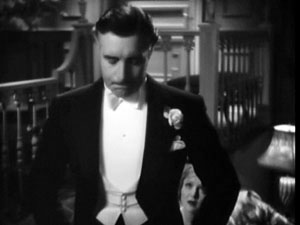
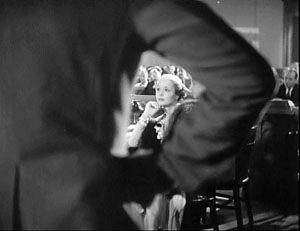
Probably the most visually and narratively complex of my films from spring 1933 is Ann Carver’s Profession. It’s possible that it was Columbia’s equivalent of an A production: Gene Raymond was a mid-range star known for a few Paramount and MGM pictures, and Fay Wray’s King Kong had premiered a week before filming started. Whatever the cause, Ann Carver has more complex plotting and more consistently inventive visuals than the three other titles.
From the very start, when gridiron hero Bill promises to provide for Ann the waitress, we get the sort of offhand flash that I like in 1930s movies. As Bill follows Ann into the kitchen, she’s framed in a swinging door and the camera moves closer to pick up their clinch.

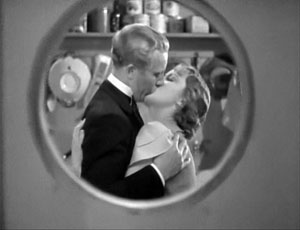
Once they’re married, the circle has become a rectangle, and trouble is on the way.
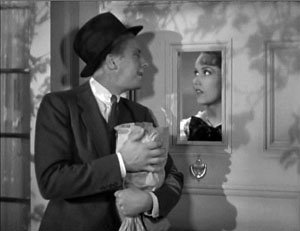
There are fancy mirror shots, pov constructions that lead characters to the wrong inferences, and examples of the big-foreground compositions that would come to prominence in the 1940s.
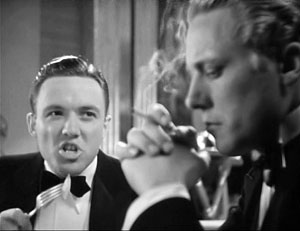
The trial recesses; crane up to the clock; spin the hands to cover a couple of hours; crane back to the trial resuming. Or start with Bill’s girlfriend, passed out and garroted by the necklace that has snagged on a leering chair carving. Dissolve to Bill’s night on the town, before ending that fuzzy montage with a dissolve back to the chair carving.
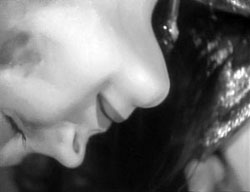
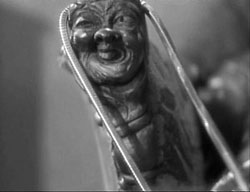
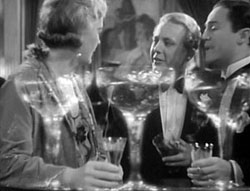
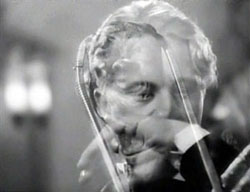
Bill didn’t kill her, but the pictorial logic makes him almost magically responsible, with the carving mocking him for what’s to come.
Above all there is one of the most laconic (and cheaply filmed) courtroom montages I’ve ever seen. A string of witnesses testifies, and after a newspaper pops out the first one, we get a fusillade of extreme close-ups, cut very quickly.
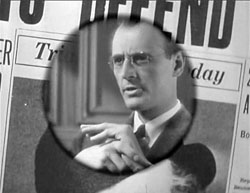
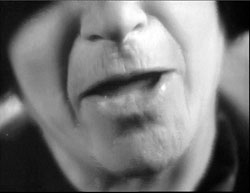
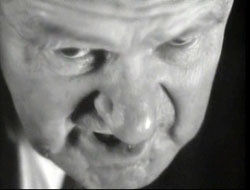
Just as striking is the coordinated sound montage, which reduces the testimony to clipped sentences, then phrases (“”Four-thirty!” “Quarter to five!” “Both of ‘em!”), then single words (“Drunk!” “Drunk!” “Strangulation!”), all damning Bill. Why take us through all the rigamarole—people sworn in and questioned at length—when you can give the essence of it in twenty-eight shots and twenty-five seconds?
My 1933 quartet contains no great film; perhaps none is worth more than one viewing. But what I learned from watching ordinary movies for our Classical Hollywood Cinema book is borne out by my soundings here. We can enjoy seeing a well-honed system steering us through a story, especially when gifted people like Teddy and the two Joes are shifting the gears. We can appreciate the opportunities for grace notes in what some call formula filmmaking. And we can see that this lowly studio, making films ignored in traditional histories, has something to teach filmmakers today: proud modesty. A film can radiate pride in being concise, in exercising a craft, and in telling a story that hurtles forward while shedding moments of casual beauty.
Most critical writing on early 1930s Columbia pictures focuses on Frank Capra, but there is good general background in Bernard F. Dick, The Merchant Prince of Poverty Row: Harry Cohn of Columbia Pictures (Lexington: University Press of Kentucky, 2009). My mention of budget levels comes from his discussion on pp. 119-120. An older, citation-free but still helpful biography is Bob Thomas, King Cohn (Beverly Hills: New Millennium, 2000). In-depth information on Joseph Walker as a Columbia cinematographer is available in Joseph McBride’s excellent biography Frank Capra: The Catastrophe of Success (New York: Simon and Schuster, 1992), 189-215. Walker’s engaging autobiography supplies nothing specific to these films, but he sprinkles technical information among its anecdotes. See Joseph Walker and Juanita Walker, The Light on Her Face (Los Angeles: ASC Press, 1984).
On 1934 as the end of naughtiness, see Tom Doherty’s Pre-Code Hollywood. For a skeptical account of the idea of Hollywood “before the Code,” see Richard Maltby, “More Sinned Against than Sinning [2003],” in Senses of Cinema here, and essays in “Rethinking the Production Code,” a special issue of The Quarterly Review of Film and Video 15, 4 (1995), ed. Lea Jacobs and Richard Maltby.
If you’re interested in more complicated narrative strategies in films of this period, try our entry “Grandmaster Flashback.” For another take on low-budget 1930s films, there’s our entry on Mr. Moto and Charlie Chan.
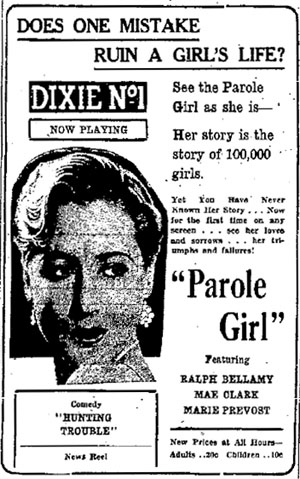
(50) Days of summer (movies), Part 1
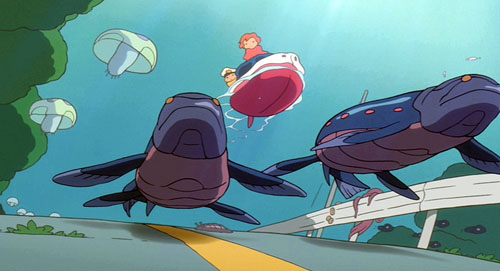
Ponyo on a Cliff by the Sea.
DB here:
Travel took me out of Madison for half of June and nearly all of July. While overseas, I saw only one recent US release. So I caught the American Summer Movies in two gulps–over a couple of weeks early on and over the last month or so. In all, exactly 50 days? Well, were there exactly 50 first dates in that movie?
Herewith, comments on a batch of titles. There are spoilers sprinkled throughout, but most of what I say won’t harm your encounter with the film. Because all my remarks amounted to an even longer blog than usual, I’ve broken it into two parts. The next installment, coming up in a few days, talks about The Taking of Pelham 123, Public Enemies, and Inglourious Basterds.
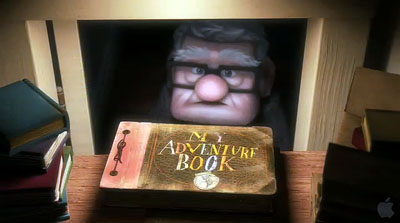
My summer movies were bracketed by two animated pictures. Up is to my mind the most mature Pixar film yet. It has all the virtues we associate with this studio: quick but not frantic pacing, expert handling of resonant motifs, technical brilliance (especially in its depiction of settings), and one-off gags. The poker-playing dogs had me laughing out loud. But as we’ve argued in other blogs (here and here and here), the Pixar team likes to set itself tough challenges. First there is the technical challenge of 3-D, which is easily surmounted. The 3-D effects get more pronounced once the plot lands in South America. More important, I think, is the challenge of representing the emotion of sorrow.
Another movie would have organized its plot around the kid, Russell, and let him meet the elderly Carl in the course of his adventures. That way, Carl would emerge as a merely touching secondary character. But by focusing point of view around Carl’s life, showing his marriage and widowhood, Pete Docter and his team have tackled one of the hardest problems of classic moviemaking. How do you render pure sentiment without becoming sentimental?
The protagonist’s portrait is surprisingly hard-edged. Carl is tightly wound even in his youth, unlike the exuberant and extroverted Ellie. Yet the couple seems to have no friends throughout their marriage, and it becomes easy to see how Carl could will himself into crabby isolation after her death. Thanks to the choice of viewpoint, Carl becomes no mere crank but a truly empathetic figure.
This is fragile stuff, and Docter handles it with tact. Many movies want you to cry at the end, but Up daringly invites you to indulge in its first ten minutes. It then spends the rest of its running time brightening your mood, so that the title could describe the film’s emotional trajectory. It’s one of my two favorite new movies I saw this summer.
Just a few days ago Kristin and I saw Ponyo on a Cliff by the Sea. We’ve been Miyazaki fans since Totoro, and have especially admired Kiki’s Delivery Service and Spirited Away. As with this last and with Howl’s Moving Castle, I have a hard time figuring out the premises of the plot. What rules govern Ponyo’s transformations? Why can’t she become a real girl, exactly? And then why is she permitted to? The well-timed interventions of her mother, like the Witch’s change of heart in Howl, seems a way out of plot difficulties, and as often happens in Miyazaki the plot resolution seems rushed in comparison with the leisurely development of characters’ relationships.
But as usual I was won over by the effortless virtuosity of the imagery and the weird conviction suffusing Miyazaki’s concept of nature. As in Spirited Away, animation becomes animistic. The sea is bursting with hidden forces: goldfish with extraordinary powers of group effort, waves that turn into blue fish, and bubbles as solid and slippery as balloons. Nobody but Miyazaki could imagine the quasi-Wagnerian scale of Ponyo’s race, atop gigantic fish-waves, to catch up with Sosuke and his mother fleeing in their car.
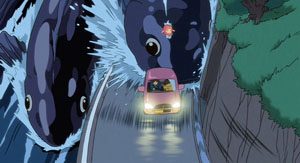
These shots burst with more dynamic shifts of mass and scale than I’ve felt in any official 3-D picture.
Sometimes Nature is scary. Although nothing here is as traumatic as Spirited Away‘s transformation of parents into swine, the tsunami scenes induce genuine awe at nature’s exuberant destructiveness. There follows a reassuring calm. Ponyo and Sosuke glide along the flood waters while ancient creatures zigzag in the depths, and the townspeople quietly accept that their homes have been engulfed. Ponyo is a gentle movie, aimed (as Miyazaki explains here) at a younger audience than was his recent work. It’s suffused with simple human affection, seen in acts of spontaneous generosity. What American movie could include a moment when Ponyo, fish become girl, offers a nursing mother a sandwich to help her make milk for her baby? Again, sentiment without sentimentality. Ponyo offers more evidence that whatever the disappointments we may find in live-action movies, we are living in a golden age of animation.
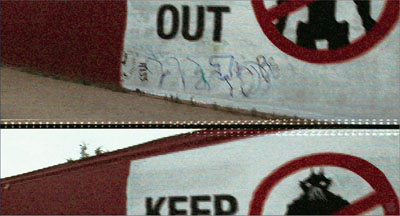
Am I just being perverse in finding Transformers 2: Revenge of the Fallen not as abysmal as others have? Don’t get me wrong. It is not what you’d call good. It is rushed and overblown. What other movie accompanies its opening company logos with gnashing sound effects? Its plot is even more preposterous than the first one’s. Its performers bear that sheen of meretriciousness that fills nearly every Michael Bay project. It is also lazy in its plotting. Worse, I couldn’t really make out the design of the ‘bots. It’s not that the cutting is abnormally swift (a mere 3.0 seconds ASL, about the same as in Up and slower than that in The Hurt Locker). The problem is that the digital camera is swirling around the damn things so fast as they take shape that you can’t get a fix on what they actually look like. All those spinning wheels and dangling carburetors ought to be worth a glance.
But still….For non-Transformers shots Michael Bay at least puts his camera on a tripod, which these days counts as a plus with me. And a minibot humps the heroine’s leg. And John Turturro is in it. Would he grace a movie that signals the fall of Western Civilization?
 In a similar vein but more satisfying was District 9. Its “racial subtext” is as perfunctory and confused as such weighty hidden meanings usually are, and anyhow whatever political points the movie wants to make drift out of view halfway through. Moreover, its “documentary immediacy” is inconsistent: despite footage marked as coming from surveillance and TV cameras, we have unimpeded access to all plot matters. But here the Bumpicam probably allows for cheaper CGI, and as a run-around-shooting-things movie, it needs to keep things simple.
In a similar vein but more satisfying was District 9. Its “racial subtext” is as perfunctory and confused as such weighty hidden meanings usually are, and anyhow whatever political points the movie wants to make drift out of view halfway through. Moreover, its “documentary immediacy” is inconsistent: despite footage marked as coming from surveillance and TV cameras, we have unimpeded access to all plot matters. But here the Bumpicam probably allows for cheaper CGI, and as a run-around-shooting-things movie, it needs to keep things simple.
I found the smash-and-grab look far more distracting in The Hurt Locker. Kathryn Bigelow has directed several first-rate movies, notably Near Dark (where she used a tripod), Blue Steel (ditto), and Point Break (tripod mostly). On this project, she seemed to me to be doing more conventional work. There are the titles telling us that time is running out (“16 Days Left”). There’s classic redundancy of characterization, as when we’re told that James is a hot dogger–“He’s reckless!” “You’re a wild man!”–as we watch him be all that he can be, and more. There’s the hapless kid who is so near to the end of his tour that you know he’s a marked man. There are even aching slow-mo replays of explosions bowling guys to the camera. What if war films gave up this convention and just showed bombs going off and bodies hurled around as fast as in reality? Might war look a little less picturesque?
The camera is locked down for these iconic slow-mo shots, but most of the scenes are handled in heat-seeking pans, artful misframings, chopped-off zooms, and would-be snapfocusing that can’t find something to fasten on. The editing plucks out bits of local color and sprinkles in some glimpses of onlookers that tend to turn them into props. I’ve tried to show elsewhere that this trend in rough-hewn technique nonetheless adheres to the conventions of classical style: establishing/ reestablishing shots, eyelines, reactions, and close-ups to underscore story points. Even wavering rack-focus can still orient us to the action quite clearly.
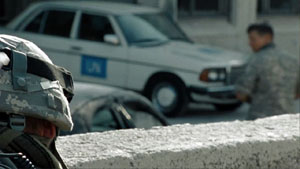
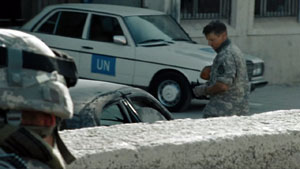
The question is what the harsher surface adds, especially when it’s so pervasive. Habituation is one of the best-proven phenomena in psychology, and movies like this seem to prove that it works. After the first few minutes, we’ve adapted to any visceral punch that the Unsteadicam hopes to provide. Maybe it serves to ratchet up suspense? Doubtful. A director would have to be a real duffer to dissipate suspense in a movie about dismantling an explosive device. The trick is to do something different, as in bomb-disposal movies like the Chinese Old Fish and the British Small Back Room.
Still, the plot is decently engaging, and there’s a taut, unpredictable siege in the desert. That long sequence displays a disciplined interplay of optical viewpoints, a sense of constantly revised tactics, a new aspect of James’s leadership style, and nice details about sharing juice boxes. In another era, The Hurt Locker would have been a studio picture in the vein of Anthony Mann’s bleak Men in War. I suppose it shows that yesterday’s genre film, executed with conviction and a certain edginess, can become today’s art movie.
Speaking of suspense: I thought that the setup to A Perfect Getaway was reasonably engrossing. There was some clever self-referential teasing: our hero’s a screenwriter, and there’s talk of a “second-act twist.” And it was mostly shot on a tripod. I hoped that director-writer David Twohy would have the courage to stick with its initial premise and be Deliverance in Hawaii. But sure enough, the things that smelled like red herrings were red herrings, and the reversal that you feared comes to pass in one of those point-of-view switcheroos that movies now indulge in. Come to think of it, that was the second-act twist. But I did like the strategically placed telemarketer call.
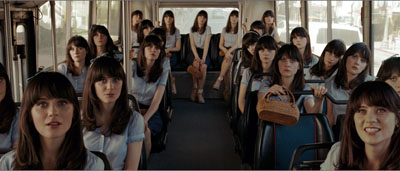
We’re evidently allotted one crossover indie movie per summer, a fact acknowledged in the title of this year’s hit. (500) Days of Summer, which really needs its parentheses not just because everybody now overuses them (there’s even a blog confessing it), but because its strategy is to disarm you with its knowing cuteness. It is so self-consciously winning your teeth will ache. It’s a twentysomething romance of the sort usually called “bittersweet.” The guy’s after love and the girl withholds commitment. Guaranteed result: emotional roller coastering, because we’ve seen her flighty sort before in kooky-girl figures like Petulia. There’s a fantasy musical number with a touch of animation, an avuncular narrating voice sliding in and out, a shuffled time scheme sorted out for us with a sort of daily odometer reading, and pop-culture references including retro ones to The Graduate and Ringo Starr. Everybody smiles a lot, and when they’re not smiling they’re crinkling up their faces.
(500) Days plays by the book. Tom and Summer work for a greeting-card company, a satiric target only a little harder to hit than the Pentagon. As in the movies mentioned above, the cutting is intent on making sure we see everybody deliver every syllable. (What ever happened to offscreen dialogue? Did TV kill it?) (Sorry about the parentheses.) The four-part script layout is as neat as embroidery: the first kiss at the photocopiers comes at 24:00, the splitup comes at 47:00, Tom delivers his diatribe against the lies about love at about 72:00, and the epilogue, with its fatal final line, finishes at 90:00. Yet I’m not curmudgeon enough to despise a movie so desperate to be liked, and at last I found a film whose narration clicks along in syncopation with my little tally counter.
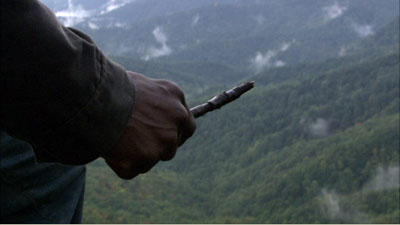
The real indie film I admired in my fifty days was Ramin Bahrani’s Goodbye Solo, or Good Bye Solo as the credit title has it. Kristin and I have registered our admiration for Bahrani’s films here and here on this site, and his latest is no less modest, well-crafted, and affecting. A Senegalese emigre cab driver befriends an enigmatic old man who at the start of the film offers him $1000 to pick him up on October 20 and drive him to Blowing Rock Mountain. Solo infers that William is planning a suicide and so starts to intervene in his life. His involvement with William gets intertwined with his family problems and his hopes of becoming an airline attendant.
Goodbye Solo exemplifies the “character-driven” movie. Solo is sunny, quick-witted, and socially adroit; his audition for the airline managers shows him as an ideal employee. William is just the opposite–morose, aggrieved, profoundly unhappy. The treatment is observational, with lengthy shots (an average of over twelve seconds) capturing dialogue and slowly shifting character response.
 The characters change, but Bahrani and his co-screenwriter Bahareh Azimi, wary of quick fixes, don’t push this too far. It would be easy to make William soften more, even eventually make him likeable, and to keep Solo an indefatigable force for optimism. Instead, if William accepts more of Solo’s ministrations, it’s largely due to his passivity, not a fundamental change of heart. Meanwhile, Solo becomes more anxious and pessimistic, shedding some of that casual charm that captivated us in the opening. Neither executes that neat character arc that Hollywood tends to favor and that’s visible in Up and (500) Days of Summer.
The characters change, but Bahrani and his co-screenwriter Bahareh Azimi, wary of quick fixes, don’t push this too far. It would be easy to make William soften more, even eventually make him likeable, and to keep Solo an indefatigable force for optimism. Instead, if William accepts more of Solo’s ministrations, it’s largely due to his passivity, not a fundamental change of heart. Meanwhile, Solo becomes more anxious and pessimistic, shedding some of that casual charm that captivated us in the opening. Neither executes that neat character arc that Hollywood tends to favor and that’s visible in Up and (500) Days of Summer.
Bahrani’s hatred of cliché obliges him to make his story events mundane and equivocal. As in Man Push Cart and Chop Shop, the plot emerges from variations in routine, a lesson well-taught by European festival cinema of the 1950s. But when you have a stubborn, taciturn character like William, and you’re restricted to another character’s range of knowledge, it’s hard to give the film a forward propulsion. You have a deadline, but no momentum. So plot dynamics arise from Solo’s relation to his wife and daughter, his career goals, and above all his investigation of William’s past–his search for what could drive the man to suicide. And this investigation turns on conveniently discovered clues.
Someday I must do a blog entry on tokens in narratives. Any plot of some complexity seems to need physical objects that encapsulate dramatic forces, spread out information, or become emotion-laden motifs. The photograph is probably the most traditional one, but notes, diaries, rings, and so on are useful too. In Goodbye Solo, William’s tokens move the drama of disclosure forward, and it’s possible to object to the film’s reliance on so many of them.
The problem Bahrani faces is that the film has to give us personal information about William while retaining tact and respect for characters’ integrity. For William to open up into a Tarantino-style confession would tear the movie apart; even a quiet moment of sobbing vulnerability is too indiscreet here. The film needs its tokens, however awkward they may seem as narrative devices, to keep faith with its people.
Staying a little outside the characters, allowing them to retain some private motives, is exactly what (500) Days of Summer doesn’t attempt. Bahrani’s discretion extends to the very last scene. The title becomes a line that someone should speak but doesn’t. Up till now, the quietly precise images have been shot by a camera locked down, but atop a mountain the camera leaves its tripod and supplies some mildly shaky imagery. And now it fits. It’s not just that the drama has reached an emotional pitch. The camera is simply buffeted by the wind. Once more Bahrani lets his world do its work.
You can read about our summer film-related travel here and here and here and here and here.
Overwhelmed by all the material on Pixar and Up, I merely point to two encyclopedic experts: the ever independent-minded Mike Barrier and the always-informative Bill Desowitz, who offers information on Pixar’s approach to 3-D here. For Ponyo background and an interview with Miyazaki, turn again to Bill D, here; he provides a transcript of a conversation between Miyazaki and John Lasseter here. A fat book of Miyazaki interviews and essays has just been published, and it includes some incendiary stuff, such as “Everything that Mr. Tezuka [Osamu, the ‘god of animation’] talked about or emphasized was wrong” (197).
The parentheses in (500) Days of Summer are explained by screenwriter Scott Neustadter at Jeff Goldsmith’s Creative Writing podcast.
Roger Ebert has reviewed nearly all these films and as always he has sensitive things to say, particularly on Goodbye Solo. He’s been championing Bahrani’s films for many years and he offers a warm career appreciation here.
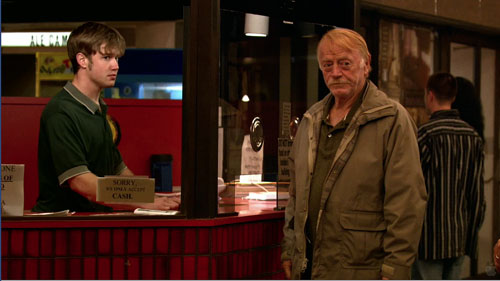
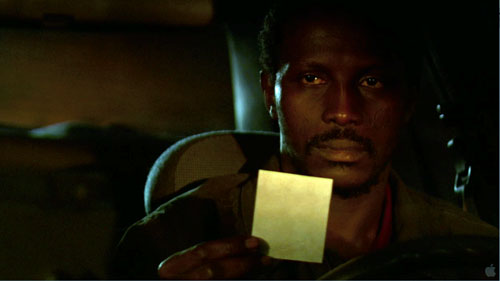
Goodbye Solo.
Class of 1960
DB here:
By now most people accept the idea that 1939 was a kind of Golden Year of cinema. You know, Rules of the Game, Stagecoach, Wizard of Oz, that movie about the Civil War, etc. TCM has even made a movie about 1939. On this site Kristin and I have talked about earlier wonder years, like 1913 and 1917. So in planning this year’s Bruges week-long Zomerfilmcollege (aka Cinephile Summer Camp), Stef Franck and I discussed building my lectures around a single year. I proposed 1941, but he countered with 1960.
1960 was a logical choice in providing spread for the whole program. At Bruges we intertwine several threads of lectures and screenings, and this year we had silent films (The Cat and the Canary, The Wind), Hollywood’s cinema of emigration (Florey, Siodmak, Ophuls, etc.), and contemporary Korean film. All in 35mm, of course. So picking 1960 filled in another area.
As so often happens, a contingent choice came to seem a necessary one. By the time I opened my mouth to introduce The Bad Sleep Well, I had convinced myself that 1960 was another watershed year. Consider these releases:
Rocco and His Brothers (Visconti), La Dolce Vita (Fellini), L’Avventura (Antonioni), Le Testament d’Orphée (Cocteau), Plein Soleil (Clement), À bout de souffle (Godard), Les Bonnes femmes (Chabrol), La Verité (Clouzot), The Bridge (Wicki), Wild Strawberries (Bergman), The Devil’s Eye (Bergman), Lady with the Little Dog (Heifetz), The Letter that Wasn’t Sent (Kalatozov), The Steamroller and the Violin (Tarkovsky short), The Teutonic Knights (Alexander Ford), Innocent Sorcerors (Wajda), Saturday Night and Sunday Morning (Reisz), Tunes of Glory (Neame), Sergeant Rutledge (John Ford), Psycho (Hitchcock), Spartacus (Kubrick), Elmer Gantry (Brooks), 101 Dalmatians (Disney/ Reitherman), The Magnificent Seven (Sturges), Exodus (Preminger), Home from the Hill (Minnelli), Comanche Station (Boetticher), Verboten! (Fuller), The Bellboy (Lewis), The Young One (Buñuel), TheYoung Ones (Alcoriza), The Shadow of the Caudillo (Bracho), Devi (Ray), The Cloud-Capped Star (Ghatak), This Country Where the Ganges Flows (Karmakar), Red Detachment of Women (Xie Jin), The Back Door (Li Han-hsiang), Enchanting Shadow (Li Han-hsiang), The Wild, Wild Rose (Wang Tian-lin), Desperado Outpost (Okamoto), Spring Dreams (Kinoshita), When a Woman Ascends the Stairs (Naruse), Daughter, Wives, and Mother (Naruse), Cruel Story of Youth (Oshima), The Sun’s Burial (Oshima), Night and Fog in Japan (Oshima), The Island (Shindo), Pigs and Battleships (Imamura), Sleep of the Beast (Suzuki), and Fighting Delinquents (Suzuki).
We didn’t show any of them.
Several factors constrained our choices, including the availability of good prints with Dutch subtitles, or at least English ones. We also didn’t want to run too many official classics. And we fudged a little for pedagogy’s sake. We had to include a Godard, but instead of À bout de souffle, we picked Le Petit soldat—made in 1960 but not released until 1963. The World of Apu was released in 1959 in India, though it made its world impact in the following year. Lola was finished in 1960 but released in early 1961. A dodge, but I wanted a Nouvelle Vague counterpoint to Godard, and it fit well with the Ophuls thread, and—well, it’s Demy. In any case, we wound up with a list of outstanding movies.
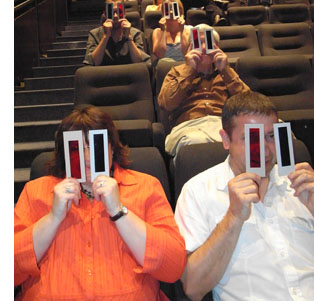 Running alongside my titles were horror films and thrillers from the same year, including Peeping Tom, Black Sunday, The Leech Woman, and Corman’s House of Usher. William Castle’s 13 Ghosts was shown with reconstructed versions of the original two-color Ghost Viewers. (Look through red if you believe in ghosts, blue if you don’t.) Imagine the shot above through a red filter. The creature, pink on the print, turns satanically crimson—confirmation that ghosts exist, although they look less like Casper and more like those Red Devil candies you ate in theatres as a kid. In a prologue, available here, Mr. Castle explains it all.
Running alongside my titles were horror films and thrillers from the same year, including Peeping Tom, Black Sunday, The Leech Woman, and Corman’s House of Usher. William Castle’s 13 Ghosts was shown with reconstructed versions of the original two-color Ghost Viewers. (Look through red if you believe in ghosts, blue if you don’t.) Imagine the shot above through a red filter. The creature, pink on the print, turns satanically crimson—confirmation that ghosts exist, although they look less like Casper and more like those Red Devil candies you ate in theatres as a kid. In a prologue, available here, Mr. Castle explains it all.
All in all, quite a week. My sessions ran from 9:00 AM to 12:30 or 1:00 PM, with the film embedded. After lunch, there were more talks and screenings, usually winding up at about 1:00 AM. Other speakers included Kevin Brownlow, Tom Paulus, Steven Jacobs, Muriel Andrin, Egbert Barten, and Christophe Verbiest (linking his talks on contemporary Korean film to the absolutely nuts 1960 Kim Ki-yong melodrama The Maid). The locals’ lectures were in Dutch, but these worthies are fluent in English, so sharing meals with them allowed me to catch up with their ideas.
Pegging a batch of movies to a single year can seem gimmicky, so I treated the films as exemplifying different trends, many of which started before 1960 and have continued since. I concentrated on trends within world film culture, though in several cases those were tied to still broader social and political developments. Above all, the 1960 frame allowed me to do the sort of comparative work I enjoy.
Generations
My first grouping was “Twilight of the Masters.” This allowed me to develop the idea that, remarkably, people who had started making films in the 1910s and 1920s were still active in the 1960s—and often making films that recalled their youthful efforts. Renoir revisited La Grande illusion in The Elusive Corporal, and Dreyer returned to his origins in tableau cinema through the staging of Gertrud.
In this connection, Fritz Lang’s 1000 Eyes of Dr. Mabuse, his final movie, revisits his Mabuse cycle in the way his previous films for Artur Brauner revise the “sensation-films” he wrote for Joe May (especially The Indian Tomb). Drawing on some ideas in my online essay, “The Hook,” we studied Lang’s crisp transitions between scenes. From this angle, 1000 Eyes is a sort of encyclopedia of ways you can connect scenes (visual link, auditory link, association of ideas, etc.). The transitions whip up a breathless pace and steer past some plot holes, and sometimes they generate a level of mistrust, implying story possibilities that don’t turn out to be valid.
Testament’s motif of eyes and vision became expanded to television surveillance in 1000 Eyes. There might even be an oblique connection between the Hotel Luxor’s panopticon and the rise of television ownership in Europe at the period. Here, as ever, cinema doesn’t have good things to say about TV.
Twilight of another, not quite so old master: Late Autumn by Ozu. I reviewed some features of Ozu’s style and then analyzed the film as a multiple-character drama. Ozu and his collaborator Noda Kogo split up the plot in order to present different characters’ attitudes to the central situation: the question of a daughter’s marriage. The plot ingeniously withholds information about the attitude of Akiko, the mother, by deleting certain scenes that would clarify it. Here too, the old master recalls earlier films by having characters discuss their college flirtations, which invoke scenes from Days of Youth and Where Now Are the Dreams of Youth?
Both Billy Wilder and Akira Kurosawa furnished me with a second generational cohort. I know, probably nobody in his right mind would see common features between these two directors. But desperation can fuel audacity. Both emerged during the late 1930s, began directing in the 1940s, and enjoyed a string of great successes in the 1950s; but both fell on harder times in the 1960s. Both became accusatory living legends, haunting local industries that had kept them from working.
Leading up to The Apartment, I considered Wilder’s contribution to two trends. First, the industry had hit the doldrums. In Europe television and new leisure lifestyles were not yet the threat they would become, but in America, the industry needed to pull its audience away from the TV set and the barbecue. Wilder proved skilful in using Hollywood’s turn to sex as the basis for his cynical comedies. The Lubitsch touch, a worldly appreciation of the oblique approach to matters of sex, was replaced by something harsher. In Wilder’s world, there are mostly sharks and shnooks, those who take and those who are taken.
Second, I situated Wilder as a leading figure in the emergence of the writer-turned-director in the 1940s (Sturges, Huston, Brooks, Fuller, Mankiewicz, etc.). This encouraged me to probe his dramaturgy, and so we analyzed the taut structure of The Apartment’s plot. It has rightly been recognized as a model screenplay, making us sympathize with a careerist covering up his bosses’ infidelities, all the while whetting our interest by shifting the range of knowledge away from the protagonist at key moments. It also displays a nice interweaving of motifs that function both dramatically and metaphorically (especially Miss Kubelik’s hand mirror). Of course at the end I had to run a clip showing the influence of The Apartment on the opening of Jerry Maguire.
By the mid-1960s, however, Wilder was pushing his luck, especially with Kiss Me Stupid. In The Apartment he wanted to make “a movie about fucking,” and he predicted that some day people would do the deed onscreen. But having glimpsed the promised land of the 1970s, he was unable to enter. Despite some worthy efforts, notably The Private Life of Sherlock Holmes, he haunted Hollywood as a major director who had outlived his moment.
Human, all too human
Kurosawa’s international fame came largely through the growth of the film festival as a prime institution of international movie culture. This situation let me sketch in the importance of festivals in bringing directors like him to world recognition. (By the way, Richard Porton has just brought out an informative collection of thoughts on film festivals.) With The Bad Sleep Well, I was able to talk a bit about something that is often forgotten—Kurosawa’s efforts in social, even political cinema. From Sugata Sanshiro, a tribute to Japanese martial arts, and The Most Beautiful, the loveliest movie you’ll ever see about girls making lenses for gunsights, up through Occupation projects like No Regrets for Our Youth and Scandal, Kurosawa engaged with political subject matter. Ikiru and I Live in Fear made this side of his work even more salient in the 1950s.
The Bad Sleep Well’s attack on corporate corruption sits well with this tendency. It considers the “iron triangle” of Japanese politics, the collusion of bureaucrats, politicians, and private industry—particularly the building industry, whose livelihood depends on bids for government projects. Still, it’s hard to believe that while Kurosawa made the film, and while Ozu made the serene Late Autumn, students were fighting police in the streets over the US-Japan security treaty. That turmoil surfaced in Oshima Nagisa’s demanding and formally daring Night and Fog in Japan.
The movie is shot with Kurosawa’s usual muscularity, including virtuoso compositions in what he called, following Toland, “pan-focus.”
The film’s twists also seemed to me worth examining. The protagonist is a minor presence in the first scenes, and his reticence in the beginning is mirrored in the finale, when he simply vanishes and his pal has to tell us what happened to him. Such a daring structure, reminiscent of the abrupt midway break in Ikiru, gives the film an almost Brechtian discomfiture, as well as highlighting the secondary characters’ rather perverse reaction to the hero’s fate.
Kurosawa was widely called a “humanist” director, and this concept sheds light on what we might call the “international film ideology” pervading festivals in the 1950s. In various areas of social and philosophical thought, a notion of humanism emerged out of disillusionment with the “age of ideology” that had engulfed the world in war. Several thinkers declared that the age of religious dogma and social collectivism, either Nazi or Communist, was over. Now what mattered were the features that drew people of all societies together, and the prospect of enlightened social action based on those commonalities—tolerance, respect, and a belief that people ultimately took individual responsibility for their communities. Catholics, Communists, and people of all stripes scrambled to call themselves humanists. As Dwight Macdonald, former Trotskyite, put it, “The root is man.”
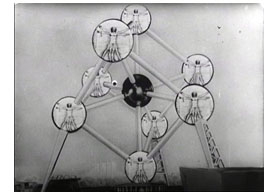 This frame of reference can be seen in Steichen’s 1955 photo exhibition, circulated around the world in a best-selling book, called The Family of Man, as well as in the 1958 Brussels Expo, the first major world’s fair since the war. There films like For a More Human World (frame right) presented technology, science, education, and cooperation as teaming up to improve the lives of people in all nations.
This frame of reference can be seen in Steichen’s 1955 photo exhibition, circulated around the world in a best-selling book, called The Family of Man, as well as in the 1958 Brussels Expo, the first major world’s fair since the war. There films like For a More Human World (frame right) presented technology, science, education, and cooperation as teaming up to improve the lives of people in all nations.
Film festivals embraced this universalism, pointing to the great films of Italy’s Neorealist trend as proof of cross-cultural communication. Although these films often scored specifically Italian political points, they could also be seen as human documents speaking to audiences anywhere. Who could not empathize with Ricci and his son in Bicycle Thieves (named at the 1958 Expo as the third-greatest film ever made)?
The turn to humanism helps answer a puzzling question: Why Satyajit Ray? Virtually no Europeans had ever seen a film from India. What enabled a director from this country to achieve worldwide renown? And why not other Indian directors of his era, such as Raj Kapoor, Guru Dutt, Mrinal Sen, and Ritwik Ghatak? All of these had to wait many years for discovery by European tastemakers.
For one thing, Ray was highly westernized himself. He was a child of the Bengali Renaissance, a virtuoso in many fields (he composed music, drew with facility, wrote detective stories and children’s books), and an admirer of European cinema. A stint assisting Jean Renoir exposed him to one of the greatest of Western filmmakers. A viewing of The Bicycle Thieves determined him to make films. He was skeptical of imitating Hollywood, which had been a prime inspiration for Hindu cinema. He criticized Bollywood’s reliance on schematic romance and musical numbers. If any Indian director was to make the move to the festival circuit, it would be him. (You can argue that other non-European filmmakers who made it into the fold were the most “western”—Kurosawa, Leopoldo Torre Nilsson, etc.).
Just as important, Ray’s stories suited the humanist program. Whereas Ghatak and Sen made politically charged films, Ray concentrated on the individual. In The World of Apu, social conditions are shown, but as a background to the development of personality and psychological tensions. At the film’s start, students are holding a street march demanding political rights, but they are offscreen, a backdrop to Apu’s meeting with his old professor as he gets his letter of recommendation. What follows is a drama of artistic failure, blossoming love, and a young man’s confused growth to maturity and responsibility.
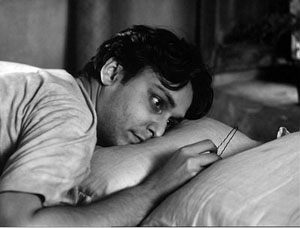
It’s a simple story, rendered lyrical through constantly developing imagery: Apu stretched out prone, the famous grimy window curtain, and a cluster of visual motifs I hadn’t noticed on previous viewing. Ray’s concise direction links the torn curtain in Apu’s room to the famous (Langian?) transition from a movie screen to a carriage window, the cluster unified by associating Apurna with male children. Thanks to Andrew Robinson’s book on Ray, we know that in the carriage scene she is already thinking of the son she will bear.
It’s easy to romanticize this handsome, happy-go-lucky hero. I think the College participants thought I was a little hard on Apu, since I treated him as far from the “conscientious and diligent” young man his professor wrote of. Surely his idealistic-novelist persona is sympathetic. But if he is to grow as the film suggests, he must have failings, and Ray shows them to us—dreamy indolence, self-centeredness, even poutiness. The film is a character study, a sort of Bildungsroman tracing how Apu learns his place in his world. Our discussion after this film was particularly rich, with one participant suggesting that in accepting his son he isn’t abandoning his art entirely, but giving it human significance: He promises to tell Kajal stories.
Ray came to directing in middle age, a somewhat rare option. So too did Gillo Pontecorvo, but the latter made many fewer films. Although Kapò, isn’t as strong a movie as our other entries, it did allow us to talk a bit about coproduction, about European cinema’s relation to World War II, and about what came to be known as the morality of technique.
European coproductions are another fundamental part of the 1960 landscape, and they illustrate how economic considerations penetrate artistic choices. (Why are American and Italian actors in the “German” film 1000 Eyes of Dr. Mabuse? Why do we find Anouk Aimée in 8 ½ and Jeanne Moreau in La Notte? Follow the money.) For the Italian production Kapò, the primary roles are taken by an American (Susan Strasberg, playing the heroine Edith) and two French actors—the concentration camp translator played by Emmanuelle Riva and the heroic Soviet soldier played by Laurent Terzieff. The film was shot in Yugoslavia.
The story centers on a young Jewish girl who, in order to survive Nazi internment, passes herself off as a Gentile and becomes a camp commandant, whipping other prisoners into line. Other Italian films of the period, notably Rossellini’s Generale Della Rovere, were dealing with issues of conscience during the war, but Kapò was apparently the first fictional feature in Western Europe to confront the Holocaust since Alessandrini’s Wandering Jew of 1947. In 1960, Adolf Eichmann had been captured by the Mossod and stood trial the following year, and after Kapò came a few other films addressing the camps, notably Wajda’s Samson (1961) and Lumet’s The Pawnbroker (1965). So the film had a strong contemporary resonance; after its US release, it would be nominated for an Oscar.
One reason Stef and I picked Kapò was the controversy around Jacques Rivette’s accusation in Cahiers du cinéma that for a particular tracking shot Pontecorvo deserved “the most profound contempt.” The film, as Rivette indicates, is dominated by an already compromised conception of realism: grimed faces, make-up that hollows cheeks, somewhat ragged clothes, moderately shabby bunks. The shot shows the body of Theresa hurled against the electrified barbed wire, with the camera coasting slowly toward it. Her silhouette is almost classically composed, with the hands artfully pivoted and standing out against the sky. For Rivette this pictorial conceit is virtually obscene.
It seems to me that Rivette’s essay sought in part to reply to those who thought that Cahiers’ policy amounted to pure formalism. In calling for an ethics of technique, Rivette argues that artistic choices which might seem to be in the service of correct politics can betray a deeper immorality: using a historical cataclysm as an occasion for a safe realism and self-congratulatory flourishes. Similar complaints could be lodged against Kramer’s Judgment at Nuremberg and Stone’s World Trade Center. And because for the Cahiers team artistic cinema was an expression of a creator’s vision, the morally maladroit traveling shot brands the director as a man of bad faith.
Rivette isn’t saying that film artists shouldn’t try to represent historical trauma. He simply argues that other paths could be taken. For instance, Resnais’ Night and Fog and Hiroshima mon amour acknowledge that some events cannot be encompassed by normal understanding, and the form of each film enacts an effort to understand, not a fixed conclusion. What we see in Night and Fog is “a lucid consciousness, somewhat impersonal, that is unable to accept or understand or admit this phenomenon.” For Rivette, Pontecorvo seems convinced that romantic love and self-sacrifice can overcome Nazism, albeit with some help from the Red Army. He tries to explain, even prettify, an event that cannot be understood within the usual humanistic categories.
New Wave, still new
Lola.
Godard’s Le Petit soldat is far more preoccupied with uncertainties, even confusions, than Kapò is. 1960 saw an extraordinary number of former colonies, especially in Africa, gain independence, and during that year the Algerian war of resistance was spreading to Europe. Godard’s central character Bruno is working with the OAS vigilantes dedicated to killing Algerian terrorists, but when he meets the lovely Veronica Dreyer he decides to leave politics behind and flee with her to Brazil. Perhaps “decides” is the wrong word, since his actions are impulsive: he abruptly shies away from committing a political assassination, and he abruptly abandons his colleagues. But he’s captured by FLN terrorists and, in the film’s most famous sequences, tortured. At the end, he commits the assassination, not knowing that Veronica, herself in league with the Algerians, has been captured by his pals and killed. But his final voice-over is almost a shrug, and his act of murder takes on the flavor of an existentialist acte gratuite.
Le Petit soldat doesn’t offer heroic figures, as Kapò does in Theresa and the Soviet soldier. Nor does it allow us to sympathize much with the egotistical, capricious Bruno. The texture is more disjunctive, littered with the usual digressions and citations. Since the film was shot in Geneva, there’s a persistent motif of Swissness, with citations of Paul Klee. A sneaky one I never noticed before: the seduction game Bruno plays is modeled on the three fundamental shapes in the Bauhaus basic course, which Klee taught.
Having experimented with discontinuous imagery in À bout de souffle, Godard in his second feature turns his attention to the soundtrack, creating one of the most minimalist ones I know. If Bresson whittles down his soundtrack to a spare but recognizable realism, Le Petit soldat goes a step further, scrubbing out nearly every noise until we’re almost watching a silent film. Traffic scenes lack traffic noises, with only a car horn or a bit of dialogue breaking in. One passage on a train could almost be a sound loop.
The strategy of suppressed sound is carried to a paroxysm in the torture scenes, with the clink of handcuffs and the soft tapping of typewriter keys highlighted and bits of music played spasmodically…but no sounds of pain. Only during the rushed and almost throwaway climax, is something like a plausible city ambience heard. In a dichotomy that will be familiar throughout Godard’s work, there’s a split between image (Bruno is a photographer, and in the early part of the film he takes snapshots of Veronica in her apartment) and sound (the political factions rely on telephones and tape recorders, and the OAS thugs trick their way into Veronica’s apartment through sound recording).
In all, Le Petit soldat isn’t exactly fun but it’s exhilarating in its bursts and unexpected frictions. Next time somebody tells me that Godard’s technical innovations have all become commonplace, I’ll point to this film of 1960, which would be daring and demanding if released tomorrow.
Fun, albeit grave, is what Lola is all about. It takes formal artifice far beyond realism, creating a sort of non-musical musical. (It has one number, and even that is a sketchy rehearsal.) As geometrical as a minuet, its plot plays out in a hall of mirrors, where characters share names, pasts, and sentiments. The sailor Frankie and the wandering Michel, both in love with Lola, are blonde giants. Lola is actually named Cécile, and the little girl of the same name seems in some ways an early version of her, while Cécile’s mother has a dash of Lola in her past.
Roland starts out as the protagonist, but as he warms and cools and warms to Lola, the story momentum shifts to others. There’s Lola of course, and young Cécile who strikes up a friendship with Frankie, and Cécile’s mother who yearns a bit for Roland, and Michel, who left Nantes years ago and has lived in another movie, specifically, Mark Robson’s Return to Paradise (1952). Here the structure of the plot unfolds the network of relationships among people, linked mostly by casual encounters across a few days. The last section accordingly consists of a series of farewells, as if the story can end only by breaking ties of affection.
In surveying these films, I was struck by how much most of them owed to the growth of postwar institutions of film culture, and how strong those institutions remain. Coproductions and subsidies were feeding a massive buildup of European cinema. Contrary to what you might expect, as attendance cratered from the late 1950s onward, the number of European films produced went up. The EU countries still overproduce, releasing nearly 1200 theatrical features in 2008.
Film festivals were promoting not only universal humanism; they were also packaging films under rubrics of authorship or the New XXX Cinema and the Young ZZZ Cinema. 1940s Neorealism, aka “New Realism in Italian Cinema,” seems to have been, once more, the prototype. Festivals must make discoveries and emphasize novelties. At the same period film schools taught professional standards, and film archives showed classics and gave postwar filmmakers a more secure sense of the medium’s history. Lang, Ozu, and Wilder weren’t dependent on such institutions, but younger filmmakers were. And still are.
1960 is an arbitrary data point, but it stands out as an extraordinary year for quality. In addition, picking it as a benchmark allowed me to think about some important trends of the period. What probably didn’t show through my lumbering PowerPoints, with their charts, diagrams, and frame enlargements, was how much I learned from my Bruges stay. One of the deep satisfactions of teaching is remembering, no matter how confidently you declare your claims, how much more there is to know. Of things cinematic there is no end.
We also asked participants to read Serge Daney’s essay, “The Tracking Shot in Kapò.” Daney’s elaborate exercise in autobiography, irony, and moral reflection could not be plumbed in the time at my disposal, there or here. But it did help me understand Rivette’s argument. In preparing my lectures, I also owed a debt to some excellent books, notably Tom Gunning, The Films of Fritz Lang: Allegories of Vision and Modernity; Andrew Robinson, Satyajit Ray: The Inner Eye; Carlo Celli, Gillo Pontecorvo: From Resistance to Terrorism; and Richard Brody, Everything Is Cinema: The Working Life of Jean-Luc Godard. As ever, the invaluable documentation provided by the print editions of Screen Digest over the years enabled me to compile my tables of attendance, releases, and the like.
Late Autumn.
P.S. 3 Aug: Stef has posted snapshots from our Zomerfilmcollege here.
P.P.S. 3 Aug: This helpful correction from Roland-François Lack on Le Petit Soldat:
One small point: the organisation Bruno works for cannot be the O.A.S., which wasn’t active until the end of 1960.
He is working, rather, for ‘La main rouge’, a government sponsored counter-terrorist agency run by a Colonel Mercier (hence the name of Bruno’s associate).
Nice! Thanks.
Passion, mortality, and everyday life
DB, flying back from Hong Kong:
Some of the most important films playing at the Hong Kong International Film Festival were already familiar to me—Still Walking, Il Divo, Gomorrah, Ashes of Time Redux—and some of my discoveries in Hong Kong have been covered in more recent entries.
What remains? Accentuating the positive, I’ll not talk about the disappointing items, some with strong reputations. I hope to blog about others in the months to come, when I’ve had a chance to study DVDs.
In the meantime, Kristin has already touched on Beaches of Agnès, a real charmer. Varda can be whimsical without turning fey; even dressed as a potato she doesn’t seem to be trying to grab attention. The film is a digressive, passionate memoir. The background on her early life is captivating, and her career as a photographer, shooting snaps of Pierre Vilar and Gerard Philippe, furnishes a stab of pathos. A montage of beautiful boys and girls: gone. Soon we get Varda’s straightforward acknowledgment of Demy’s death from AIDS. “All the dead lead me back to Jacques.”
Götz Spielmann’s Revanche, which I’d passed up at other fests, was a very solid psychological thriller. It’s built around two contrasting worlds, the sex trade of Vienna and the placid, churchgoing lifestyle of a village. From the first comes Alex, a man-of-all-work in a brothel. He falls in love with a Ukrainian hooker, and between bouts of cocaine he vows to help her escape the business. In the village live the policeman Robert and his wife Susanne, trying to have a child. Their life is secure and cozy, though Robert is wound a bit tight. The two worlds intersect during a bank robbery, and the rest of the drama plays out in the countryside, with Alex taking refuge on his grandfather’s farm. Alex and Robert become two variants of masculine anxiety, each defined by his way with a pistol, and their decisive confrontation is deftly postponed until the very last moments of the film.
I admire the way that Spielmann uses a spare long-take technique to increase suspense. Each scene usually consists of a single shot, taken from a judiciously chosen angle that unfolds the drama smoothly. There are barely 200 shots in nearly two hours, but the scenes don’t seem stiff because the framing and staging are quietly varied. Shot/ reverse-shot cutting is reserved for two turning points, one in the middle and one at the end. It’s nice to see a movie with no filler material, no passages of people driving in cars or going into the buildings, none of those time-wasting aerial shots of cities.
Some nice sound work too! No Country for Old Men has been rightly praised for its use of offscreen noise, but the Coens look rather showoffish compared to what Spielmann has accomplished here. A shot of Robert and Susanne on their patio is accompanied by the faintest rustle on the right channel: Alex, spying on domestic happiness like a character out of Highsmith or Ruth Rendell, has slipped away.
Similarly elegant in its staging and sound work is Claire Denis’ 35 Shots of Rum. The teasing exposition—a man watches commuter trains, a young woman rides one—dares us to imagine scenarios that could involve both. Our speculations turn out to be too wild, since their relationship is the most uncomplicated to be imagined. Based frankly on Ozu’s Late Spring, 35 Shots builds up its drama through daily routines, following its principals and their neighbors in everyday situations until, quite unexpectedly, a quiet crisis blossoms. Soon one scene ends: “We could be like this forever.” Next scene: everything has been overturned, and characters must change their lives. Visually the film is a marvel, with glowing scenes of semidarkness and discreetly out-of-focus details. As in her masterful Beau Travail, Denis supplies a powerful last shot, this time of an object we’ve nearly forgotten.
Two more thoughts: In my discussion of Revanche and 35 Shots, I’ve had to be coy in explaining basic plot situations and character relationships. That’s because these films work elliptically, holding back the sort of expository information that would be given in a concentrated dose early in most classical narratives. This narrational strategy poses no problem for an academic analysis, which tends to assume that the reader has seen the film. But it’s more difficult to handle when you’re writing a review. You don’t want to spoil the viewer’s surprise by explaining a core situation that the filmmaker has chosen to unfold gradually. If reviewers of Hollywood movies can’t give away the ending, the reviewer of an art film probably shouldn’t give away the beginning, or at least the information that it keeps in suspension for some time.
In other respects, though, there isn’t a clear dividing line between the “psychological” drama of international festival cinema and the more “externally driven” action of mainstream entertainment. Popular cinema relies on physical props like clues, souvenirs, messages, and gifts to help drive the plot. So, less obviously, do art films. The two photographs in Revanche deepen the character drama while triggering a major realization. The accidentally discovered letter (a convention of melodrama akin to the overheard conversation) in 35 Shots not only explains past actions but primes us to expect some conflict to come. As Aristotle knew, stories seem to need tokens to drive character revelation and plot reversals. A narrative universal?
Japanorama
Naked of Defenses.
Many of the movies I most enjoyed were Japanese. No surprise there. I know I’m prejudiced in favor, but objectively speaking the Japanese industry has long combined high output with great diversity and depth. I’m inclined to think that across film history, the three most consistently excellent filmmaking nations have been America, France, and Japan.
During Filmart, Yoshizaki Masahiro gave a swift but informative report on the current state of Japan’s “content industry.” It is the currently the world’s second-largest national film market , but it will sooner or later be replaced by China. Currently Japanese films are reclaiming the local audience, sometimes grabbing over half the annual box office. Unfortunately, that audience isn’t growing, and with a plunging birthrate, it’s unlikely to do so. Moreover, Japanese cinema has always been difficult to export, even in Asia. The great exception, of course, is anime, but even that is starting to slump. Anime is largely a television/ video format, yielding about twice in those platforms what it yields in theatrical income. But as advertising dollars have withered in the recession, anime has been cut back.
Despite all this, Japanese companies manage to release a staggering 400 or so films per year. (What counts as a release—theatrical? direct to video?—we leave for another day.) And the variety remains remarkable, judging by what I saw during my stay in Hong Kong. Put another way: Japan makes movies that are sweet, touching, funny, silly, and peculiar to the point of perversity. Not necessarily perversion, but that’s there too. And yes, schoolgirls’ panties are involved.
 Not part of the festival, but playing in town was the diverting comedy Happy Flight. Like Airport and Airplane!, it weaves together various characters involved with a single flight. It concentrates almost completely on the professionals, from gate agents and mechanics to pilots and air hostesses. The one passenger depicted in detail rings true: After being allowed to bring an oversized bag into the cabin, he becomes a browbeating jerk.
Not part of the festival, but playing in town was the diverting comedy Happy Flight. Like Airport and Airplane!, it weaves together various characters involved with a single flight. It concentrates almost completely on the professionals, from gate agents and mechanics to pilots and air hostesses. The one passenger depicted in detail rings true: After being allowed to bring an oversized bag into the cabin, he becomes a browbeating jerk.
The film maintains its infectious pacing, adorning the action with minor-key gags like the airport’s “Somkin Room” for smokers. I also liked the moments of teamwork. When the stewardesses need a cake, they concoct one out of various packaged snacks. A young mechanic, constantly berated by his boss, thinks he’s dropped a wrench into the plane’s engine, and the whole ground crew searches the hangar for it. As with Airplane!, the final credits resolve several plotlines and add a few gags. If you like Waterboys and Swing Girls, also directed by Yaguchi Shinobu, you’d probably enjoy this.
Just as light, but a lot more intricate is Nakamura Yoshihiro’s Fish Story. Another network narrative, this one traces how Japan’s purported first punk song changed the course of history. The plot skips among periods from 1953 to 2012, when a comet is about to incinerate the earth. With many pop-culture in-jokes, from Beatles albums to The Karate Kid, this breezy, off-kilter item gets by on sheer adrenaline and on a cascade of puzzles. Why does the Fish Story song make no sense? Why does it contain a one-minute passage of silence? How are all these stories connected? And how can a song save the world? The narration cleverly withholds the basic relationships among the characters until a dizzying montage at the end wraps everything up.
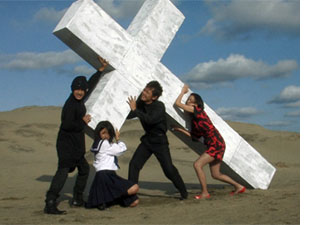 Still further out there on the Nutsometer is Love Exposure, your basic four-hour inquiry into Christianity, cross-dressing, superheroics, and schoolgirl underwear. The story starts with a boy who promises his mother he’ll marry a woman like the Virgin Mary, but thanks to digital photography and an acrobatic approach to filming schoolgirls’ nether regions, he becomes known to his peers as King of the Perverts. Director Sion Sono satirizes cult religions, which seems to include Catholicism (“Your sin is that you can’t remember your own sin”), while devoting some attention to pornographic movies and “Candle in the Wind.” Rambling and digressive, but rapidly paced, Love Exposure proves that nobody beats the Japanese for cheerful dirty fun.
Still further out there on the Nutsometer is Love Exposure, your basic four-hour inquiry into Christianity, cross-dressing, superheroics, and schoolgirl underwear. The story starts with a boy who promises his mother he’ll marry a woman like the Virgin Mary, but thanks to digital photography and an acrobatic approach to filming schoolgirls’ nether regions, he becomes known to his peers as King of the Perverts. Director Sion Sono satirizes cult religions, which seems to include Catholicism (“Your sin is that you can’t remember your own sin”), while devoting some attention to pornographic movies and “Candle in the Wind.” Rambling and digressive, but rapidly paced, Love Exposure proves that nobody beats the Japanese for cheerful dirty fun.
A more straightforward Japanese entry in the Asian Digital competition was Ichii Masahide’s Naked of Defenses (the most awkwardly titled film I saw). Two women work at a factory making plastic parts. Ritsuko, a plain but dogged supervisor, is becoming alienated from her husband after her miscarriage. She envies the pregnant and insouciant new hire Chinatsu, whose marriage is overcoming its problems. Plain and sincere in its technique, Naked of Defenses ends with an astonishing sequence. By all the evidence onscreen, Ichii got a pregnant woman to play Chikatsu and filmed her giving birth. Balancing this powerful ending is the striking performance of Moriya Ayako as a woman sinking into depression but who may be saved by friendship and maternal love.
I took the occasion to catch Departures at a local theatre, since I had missed it at earlier festivals. And I’m happy to report that it’s distributed in the US by Regent Entertainment, run by Wisconsin graduate and old friend Steven Jarchow.
By now you’ve probably seen Departures too. At one level, it’s a good old-fashioned Shochiku movie, mixing tears and good-natured humor. Some decry it as middlebrow sentiment, but I found it a touching, fluent tale. For me, the central attraction is the repertory of gestures. Our two professionals handle the recently deceased tenderly, but that doesn’t preclude a crisp efficiency in flaring out a sleeve. I don’t think I’ll forget the way the undertaker grasps the dead person’s clasped hands and then executes a circular snap. Precise manipulation becomes a sign of respect.
And it isn’t all sunniness. Handling dead bodies is hazardous cultural territory in Japan. It is traditionally a task for the burakumin, a minority group long looked down upon. Although discrimination against the group has apparently diminished, the fact that a big star like Motoki Masahiro could play the role of a corpse-preparer could help dispel a lingering social stigma.
You could almost mount a Japanese film festival about mortality. Some musts would be Ozu’s Brothers and Sisters of the Toda Family and Tokyo Story, Kurosawa’s To Live, and Kore-eda’s After Life. Another required item would be Dying at a Hospital (1993), a rarely seen Ichikawa Jun film screened as part of a tribute to the recently deceased director. It consists of staged episodes showing a few cancer patients in their last months. An elderly husband and wife both have cancer, but must separate and be treated in different hospitals. A widow laments her rotten luck. A lively young man can’t accept the fact that he won’t see his children grow up. A homeless man is brought in, filthy and disoriented, and as he becomes aware of his plight, he still apologizes for accidentally turning up his pocket radio.
These and other cases are accompanied by voice-over narration from the doctor and nurse who treat them. Interspersed with these scenes are rapid documentary montages of people enjoying life—eating, drinking, viewing cherry blossoms, celebrating festivals, just walking down the street. The intimate facial reactions we’re denied in the hospital scenes are supplied in these vérité passages.
Dying at a Hospital is gentle and sympathetic, but its manner of shooting gives it special resonance. The hospital scenes are shot in planimetric fashion, with the camera rigidly facing a row of three beds, or a pair of beds, or only a single one. Everything is played in long shot, with no close-ups or camera movements to enlarge the faces.
Patients, visitors, and hospital staff move through these blocks of space. The lighting effects are particularly subtle, accentuated by very gradual fade-ins and fade-outs, as if dawn were breaking or night were coming on. As the film goes on, Ichikawa introduces variations in scale and new cutting patterns, creating what I called in Narration in the Fiction Film a sparse version of parametric narration. For instance, the spaces become more compact as terminal patients are shifted from a shared room to a private one, which permits nuanced effects of distant depth.
Ichikawa’s dry, physically detached treatment lets the poignancy of each situation emerge without any directorial boosting. The glimpses of daily life outside the hospital, zestful and shot on the fly, generate a powerful contrast: the preciousness of ordinary pleasures, and the dignity that must be accorded everyone about to leave them behind.
For a brief but sensitive appreciation of 35 Shots, see Ryland Walker Knight’s comments here–perhaps best read, for reasons mentioned above, after you’ve seen the film.
Departures.












